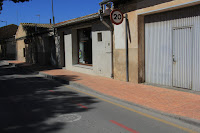Beer. I went in a pub and bought a pint of bitter. I had no idea what to ask for from all the strangely named brews but whatever I bought tasted like proper British beer. I have nothing against the beer I can get in any bar in Spain but the stuff I was buying in England was much more interesting. I had to be sure though so I visited a fair number of pubs.
Heat. It's hot in the UK. It was sometimes a tad cold outside but inside it was roasting. I haven't walked around in shirt sleeves inside in Spain for months. It was horribly dark though. Grey.
Streetfood. From time to time people eat in the street in Spain but, generally, only where there is some sort of event - like a Mediaeval Fair or fiesta. In the UK people were walking down the street eating all sorts of take away food. In Cambridge the woman on the bench next to me polished off a whole tray of sushi using chopsticks whilst the wind blew and the sky drizzled.
Restaurants, takeaways and food outlets were everywhere. We have plenty of bars and restaurants here too but the huge variety of food in the UK was noticeable.
Shops seemed much more adventurous than the shops I have become used to. There are plenty of interesting places in bigger cities here but I was in St Ives and Ely, as much as Cambridge, and even there the breadth of retail was impressive.
Work. Lots of people asked me about my work and I responded by asking about theirs. Work is a long way down the list of conversational topics in Spain: long after family, food, Spanish, the weather etc.
Money. No wonder everyone in the UK waves their credit card at the machine to pay for everything. Things seemed expensive to us though I suppose price bears a direct relationship to income. Nonetheless things do cost a lot of pounds and you would need to carry a lot of cash to keep up. I know young people use credit cards more than older people here in Spain but the terminals are not as obvious and ubiquitous as they are in England.
I was constantly taken unawares by cars driving on the wrong side of the road. More than once I thought a car was out of control simply because it was on the side of the road I am no longer accustomed to.
English. Everyone tells me that the UK is full of people from different countries but it was great to be able to speak freely and competently. Well except in Starbucks where successfully buying a cup of coffee seemed to require passing the specialist subject round on Mastermind.
Police. There weren't any. Short of the vested and impressively armed police at the airport I didn't see a police officer on foot. In Spain the police walk around all the time.
Bags. We still get plastic bags when we buy things in Spain. It struck me as a good thing that they are not given away with gay abandon in the UK but it did leave me struggling with armfuls of small items at times.
Skin. I nearly forgot this. In all seriousness I asked Maggie's niece if there was a fashion for women to wear very white face makeup with bright red lipstick and pronounced eye makeup. The answer was no. Apparently Britons are a fair bit paler skinned than Spaniards.
And a special mention for the guided bus. It's an ordinary bus that can be driven around the streets but, between Cambridge and St Ives the bus runs along the route of the old train lines in a sort of concrete conduit with little guide wheels sticking out to the side. Most impressive.



